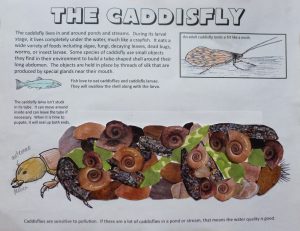Caddisfly drawing project
PURPOSE OF PROJECT: To learn about caddisfly larvae and the amazing tube houses they build for themselves, and to learn about environmental indicator species.
TARGET AGE GROUP: 8 to 12
MATERIALS NEEDED: can vary depending on what you want to use for the tube houses (copies on paper or card stock, pencils, colored pencils or crayons, glue sticks, scissors, optional collage materials as listed below
***********************************
The caddisfly is an important aquatic insect because it can be used as an indicator species. An indicator species is a plant or animal that is more susceptible to the effects of pollution. Populations of indicator species will decline before anything else, so by watching these species scientists are able to see early warning signs of possible contamination of the environment. Caddisflies are also important to fly fishermen, as the caddisfly is a major food source for fish. Fly fishermen make artificial lures that imitate either larva or adult caddisflies.
***********************************
I recommend using the following videos to learn about caddisflies:
1) Short overview of caddisfly, with easy to understand explanations:
https://www.youtube.com/watch?v=_V2_aWmjpow&t=46s
2) Up-close video of caddisfly larvae creating their house tubes:
https://www.youtube.com/watch?v=Z3BHrzDHoYo&t=2s
3) How the DEEP LOOK film crew made the up-close video:
https://www.youtube.com/watch?v=Z3BHrzDHoYo&t=2s
4) Time lapse film of caddisfly pupa hatching into adult:
https://www.youtube.com/watch?v=V0WGPwNp2MY&t=1s
***********************************
OPTIONS FOR THIS PROJECT:
For older students, you might want to have them draw the larva themselves.
Download and print this template page (Caddisfly template page DIY) and use it with this instructional video:
https://www.youtube.com/watch?v=ZoQWvHiKy8M&feature=youtu.be
(You can also access this video by clicking on the VIDEOS tab, then clicking on INVERTEBRATE ART VIDEOS, then looking for the caddisfly video at the bottom of the page.)
You will also need this template page for the tube house flap. Caddisfly larva drawing tube house templates
For younger students, you will probably want to use this page with the larva already drawn.
Download and print this template page: Caddisfly template page with larva drawn for you
You will also need this template page for the tube house flaps. Caddisfly larva drawing tube house templates
You will need to decide what materials to provide for the tube house. You can use cut paper, or you could provide a selection of materials including bits of fabric or felt, scraps of craft material, artificial leaves, hard macaronis, real bark, etc. A caddisfly will use whatever it finds in its environment, so you could even be wildly creative and give your caddis larvae things like flat-backed plastic gem stones. If you are adept at finding and using images from the internet, you might also download some images of twigs or bark or leaves, or freshwater snail shells (snail shells are commonly used by the larvae).
In my example, above, I cut out paper pictures of shells, bark and stones.
You could also have your student(s) draw objects using colored pencils or markers.
PAPER OPTIONS:
–If you are going to use heavy or thick items for you tube house collage, I recommend that you print the template pages onto white card stock. In this case, you might also want to print the info page onto card stock, also.
–If you want to let your students use watercolor paints on the larva, print the page onto card stock. (I did this for one of my classes. They love to paint.)
–If they will be simply drawing the objects with pencils, pens or markers, you could copy both pages onto regular paper.
It isn’t hard to figure out where the flap is supposed to go. You can use this picture as a guide:



